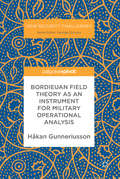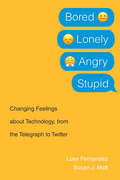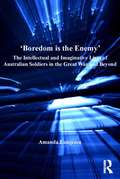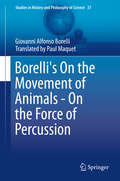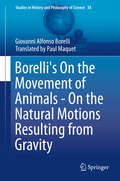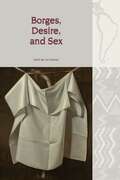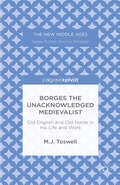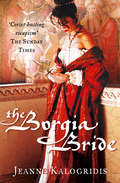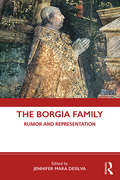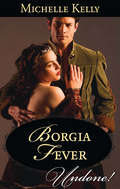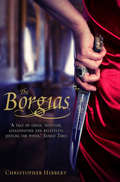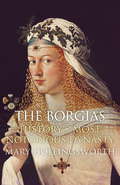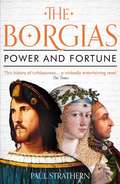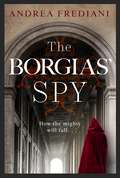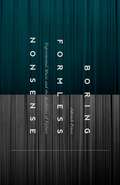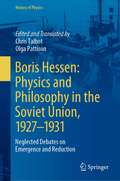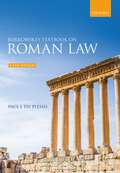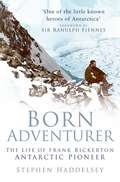- Table View
- List View
Bordieuan Field Theory as an Instrument for Military Operational Analysis
by Håkan GunneriussonThis book is open access under a CC BY 4.0 license.This book uses Pierre Bourdieu’s field theory as a lens through which to examine military operations. Novel in its approach, this innovative text provides a better, more nuanced understanding of the modern ‘battlespace’, particularly in instances of prolonged low-intensity conflict. Formed in two parts, this book primarily explores the scope of Bourdien theory before secondly providing a detailed case study of the Yugoslavian succession war of 1990-1992. Gunneriusson suggests that although theories do not necessarily provide answers, they do help us ask better questions. This volume suggests news lines of interdisciplinary investigation that will be of interest to members of armed forces, practitioners from NGOs, and policymakers.
Bored, Lonely, Angry, Stupid: Changing Feelings about Technology, from the Telegraph to Twitter
by Luke FernandezFacebook makes us lonely. Selfies breed narcissism. On Twitter, hostility reigns. Pundits and psychologists warn that digital technologies substantially alter our emotional states. But Luke Fernandez and Susan Matt show that technology doesn’t just affect how we feel from moment to moment—it changes profoundly the underlying emotions themselves.
Bored, Lonely, Angry, Stupid: Changing Feelings about Technology, from the Telegraph to Twitter
by Luke Fernandez Susan J. Matt“Technologies have been shaping [our] emotional culture for more than a century, argue computer scientist Luke Fernandez and historian Susan Matt in this original study. Marshalling archival sources and interviews, they trace how norms (say, around loneliness) have shifted with technological change.” —Nature “A powerful story of how new forms of technology are continually integrated into the human experience…Anyone interested in seeing the digital age through a new perspective should be pleased with this rich account.” —Publishers Weekly Facebook makes us lonely. Selfies breed narcissism. On Twitter, hostility reigns. Pundits and psychologists warn that digital technologies substantially alter our emotional states, but in this lively look at our evolving feelings about technology since the advent of the telegraph, we learn that the gadgets we use don’t just affect how we feel—they can profoundly change our sense of self. When we say we’re bored, we don’t mean the same thing as a Victorian dandy. Could it be that political punditry has helped shape a new kind of anger? Luke Fernandez and Susan J. Matt take us back in time to consider how our feelings of loneliness, vanity, and anger have evolved in tandem with new technologies.
'Boredom is the Enemy': The Intellectual and Imaginative Lives of Australian Soldiers in the Great War and Beyond
by Amanda LaugesenWar is often characterised as one percent terror, 99 per cent boredom. Whilst much ink has been spilt on the one per cent, relatively little work has been directed toward the other 99 per cent of a soldier's time. As such, this book will be welcomed by those seeking a fuller understanding of what makes soldiers endure war, and how they cope with prolonged periods of inaction. It explores the issue of military boredom and investigates how soldiers spent their time when not engaged in battle, work or training through a study of their creative, imaginative and intellectual lives. It examines the efforts of military authorities to provide solutions to military boredom (and the problem of discipline and morale) through the provisioning of entertainment and education, but more importantly explores the ways in which soldiers responded to such efforts, arguing that soldiers used entertainment and education in ways that suited them. The focus in the book is on Australians and their experiences, primarily during the First World War, but with subsequent chapters taking the story through the Second World War to the Vietnam War. This focus on a single national group allows questions to be raised about what might (or might not) be exceptional about the experiences of a particular national group, and the ways national identity can shape an individual's relationship and engagement with education and entertainment. It can also suggest the continuities and changes in these experiences through the course of three wars. The story of Australians at war illuminates a much broader story of the experience of war and people's responses to war in the twentieth century.
'Boredom is the Enemy': The Intellectual and Imaginative Lives of Australian Soldiers in the Great War and Beyond
by Amanda LaugesenWar is often characterised as one percent terror, 99 per cent boredom. Whilst much ink has been spilt on the one per cent, relatively little work has been directed toward the other 99 per cent of a soldier's time. As such, this book will be welcomed by those seeking a fuller understanding of what makes soldiers endure war, and how they cope with prolonged periods of inaction. It explores the issue of military boredom and investigates how soldiers spent their time when not engaged in battle, work or training through a study of their creative, imaginative and intellectual lives. It examines the efforts of military authorities to provide solutions to military boredom (and the problem of discipline and morale) through the provisioning of entertainment and education, but more importantly explores the ways in which soldiers responded to such efforts, arguing that soldiers used entertainment and education in ways that suited them. The focus in the book is on Australians and their experiences, primarily during the First World War, but with subsequent chapters taking the story through the Second World War to the Vietnam War. This focus on a single national group allows questions to be raised about what might (or might not) be exceptional about the experiences of a particular national group, and the ways national identity can shape an individual's relationship and engagement with education and entertainment. It can also suggest the continuities and changes in these experiences through the course of three wars. The story of Australians at war illuminates a much broader story of the experience of war and people's responses to war in the twentieth century.
Borelli's On the Movement of Animals - On the Force of Percussion (Studies in History and Philosophy of Science #37)
by Giovanni Alfonso BorelliThis volume provides an introduction to Borelli’s theory on the movement of animals and demonstrates the nature of the energy of percussion, its causes, properties and effects. Building on and moving away from the theory of mechanics as formulated by Aristotle and Galileo and countering objections expressed by Stephani degli Angeli among others, Borelli presents a completely mechanical account of the action of muscles and analyzes the way in which the center of gravity of the animal shifts in locomotion.Originally published in Italian in 1667, then translated into Latin in 1686, the text of this volume has now been translated into English, making the text accessible to a wide readership.This volume is the first of two volumes that contain the Introduction and physical-mathematical illustrations necessary to understand Giovanni Alfonso Borelli’s work On the Movement of Animals, the founding text of seventeenth century biomechanics. The second volume, entitled On The Natural Motions Resulting From Gravity, describes his theory and scientific experiments relating to the natural movements of bodies in a fluid environment.
Borelli's On the Movement of Animals - On the Natural Motions Resulting from Gravity (Studies in History and Philosophy of Science #38)
by Giovanni Alfonso BorelliThis volume provides an introduction to Borelli’s theory on the movement of animals and describes his theory and scientific experiments relating to the natural movements of bodies in a fluid environment. It describes in great detail why and how bodies which present with different magnitudes, weights and shapes move at a greater or a smaller velocity in certain proportion in the fluid environment.Originally published in Italian in 1667, then translated into Latin in 1686, the text of this volume has now been translated into English, making the text accessible to a wide readership.This volume is the second of two volumes that contain the Introduction and physical-mathematical illustrations necessary to understand Giovanni Alfonso Borelli’s work On the Movement of Animals, the founding text of seventeenth century biomechanics. The first volume, entitled On the Force of Percussion, demonstrates the nature of the energy of percussion, its causes, properties and effects.
Borgata: A History of the American Mafia
by Louis FerranteThe American mafia has long held powerful sway over our collective cultural imagination. But how many of us truly understand how a clandestine Sicilian criminal organisation came to exert its influence over nearly every level of American society?In BORGATA: RISE OF EMPIRE, former mafia member Louis Ferrante pulls back the curtain on the criminal organisation that transformed America. From the potent political cauldron of nineteenth-century Sicily to American cities such as New Orleans, New York and the gangster's paradise of Las Vegas, Ferrante traces the social, economic and political forces that powered the mafia's unstoppable rise. We follow the early mob as they provide alcohol to the American public during prohibition, aid U. S. Naval Intelligence during the Second World War, establish a gambling mecca in the Nevada desert - and unofficially take control of the island of Cuba.Ferrante's vivid portrayal of early American mobsters - among them Lucky Luciano, Vito Genovese, Frank Costello and Meyer Lansky - fills in crucial gaps of mafia history to deliver the most comprehensive account yet of the world's most famous criminal fraternity.This volume is the first in a groundbreaking new trilogy from a man who has seen it all from the inside. Ferrante's masterful account journeys from the group's inauspicious beginnings to the height of their power as the most influential organised criminal network in America.
Borges, Desire, and Sex (Liverpool Latin American Studies #18)
by Ariel de la FuenteAn Open Access edition of this book is available on the Liverpool University Press website and through Knowledge Unlatched.The Argentine Jorge Luis Borges, one of the most sophisticated writers of the twentieth century, suffered from sexual impotence. This emotionally overwhelming condition shaped his literary experience in ways that have not been understood. Until now Borges has largely been considered an asexual author who could not read, think, or write about desire and sex, but in this book historian Ariel de la Fuente shows that sexuality was a major preoccupation for him, both as a reader and as an author. De la Fuente has conducted an extensive literary investigation in Borges’s figurative erotic library and presents for the first time a study of the relationship between Borges’s sexual biography, his erotic readings, and the writing of desire and sex in his work. The author explores relevant literary questions while employing a historical method and the book is truly an interdisciplinary study at the intersection of history with Latin American, European, and Eastern literatures, poetry, philosophy, and sexuality. Argued with clarity, Borges, Desire, and Sex offers an unexpected perspective on the literature and figure of a world-wide influential author.
Borges the Unacknowledged Medievalist: Old English and Old Norse in His Life and Work (The New Middle Ages)
by M. ToswellThe Argentinian writer and poet Jorge Luis Borges (1899-1986) was many things during his life, but what has gone largely unnoticed is that he was a medievalist, and his interest in Germanic medievalism was pervasive throughout his work. This study will consider the medieval elements in Borges creative work and shed new light on his poetry.
The Borgia Bride
by Jeanne KalogridisThis sweeping historical novel tells the dramatic tale of that most intriguing of Renaissance women, Lucrezia Borgia.
The Borgia Family: Rumor and Representation
by Jennifer Mara DeSilvaThe Borgia Family: Rumor and Representation explores the historical and cultural structures that underpin the early modern Borgia family, their notoriety, and persistence and reinvention in the popular imagination. The book balances studies focusing on early modern observations of the Borgias and studies deconstructing later incarnations on the stage, on the page, on the street, and on the screen. It reveals how contemporary observers, later authors and artists, and generations of historians reinforced and perpetuated both rumor and reputation, ultimately contributing to the Borgia Black Legend and its representations. Focused on the deeds and posthumous reputations of Pope Alexander VI and his children, Cesare and Lucrezia Borgia, the volume charts the choices made by the family and contextualizes them amid contemporary expectations and reactions. Extending beyond their deaths, it also investigates how the Borgias became emblems of anti-Catholic and anti-Spanish criticism in the later early modern period and their residing reputation as the best and worst of the Renaissance. Exploring a spectrum of traditional and modern media, The Borgia Family contextualizes both Borgia deeds and their modern representations to analyze the family’s continuing history and meaning in the twenty-first century. It will be of great interest to researchers and students working on interdisciplinary aspects of the Renaissance and early modern Italy.
The Borgia Family: Rumor and Representation
by Jennifer Mara DeSilvaThe Borgia Family: Rumor and Representation explores the historical and cultural structures that underpin the early modern Borgia family, their notoriety, and persistence and reinvention in the popular imagination. The book balances studies focusing on early modern observations of the Borgias and studies deconstructing later incarnations on the stage, on the page, on the street, and on the screen. It reveals how contemporary observers, later authors and artists, and generations of historians reinforced and perpetuated both rumor and reputation, ultimately contributing to the Borgia Black Legend and its representations. Focused on the deeds and posthumous reputations of Pope Alexander VI and his children, Cesare and Lucrezia Borgia, the volume charts the choices made by the family and contextualizes them amid contemporary expectations and reactions. Extending beyond their deaths, it also investigates how the Borgias became emblems of anti-Catholic and anti-Spanish criticism in the later early modern period and their residing reputation as the best and worst of the Renaissance. Exploring a spectrum of traditional and modern media, The Borgia Family contextualizes both Borgia deeds and their modern representations to analyze the family’s continuing history and meaning in the twenty-first century. It will be of great interest to researchers and students working on interdisciplinary aspects of the Renaissance and early modern Italy.
Borgia Fever (Mills And Boon Historical Undone Ser.)
by Michelle KellySummoned to Rome for her skills as an apothecary, Bella has already had more than enough of the wickedly decadent papal court. Though protected—for now—by the powerful Borgia family, she knows her very life depends on accomplishing the task she has been set.
The Borgias: A Tale Of Greed, Nepotism, Assassination And Relentless Jostling For Power
by Christopher HibbertThe name Borgia is synonymous with the corruption, nepotism, and greed that were rife in Renaissance Italy. The powerful, voracious Rodrigo Borgia, better known to history as Pope Alexander VI, was the central figure of the dynasty. Two of his seven papal offspring also rose to power and fame - Lucrezia Borgia, his daughter, whose husband was famously murdered by her brother, and that brother, Cesare, who served as the model for Niccolo Machiavelli's The Prince. Notorious for seizing power, wealth, land, and titles through bribery, marriage, and murder, the dynasty's dramatic rise from its Spanish roots to its occupation of the highest position in Renaissance society forms a gripping tale.Erudite, witty, and always insightful, Hibbert removes the layers of myth around the Borgia family and creates a portrait alive with his superb sense of character and place.
The Borgias: History's Most Notorious Dynasty
by Mary HollingsworthThe Borgias have become a byword for pride, lust, cruelty, avarice, splendour and venomous intrigue. An inspiration for many works of fiction, most famously Mario Puzo's The Godfather, they have aroused abomination and fascination in almost equal measure, while their patronage of the arts created some of the great masterpieces of the Renaissance. From the powerful, merciless Rodrigo Borgia, better known as Pope Alexander VI, to the beautiful Lucrezia and the debauched and murderous Cesare, Mary Hollingsworth's account of the dynasty's dramatic rise from its Spanish roots to the heights of Renaissance society forms a compelling tale of brutality, incest, unparalleled corruption and extortionate greed.
The Borgias: Power and Fortune
by Paul Strathern'A wickedly entertaining read' The TimesA Daily Mail Book of the WeekThe sensational story of the rise and fall of one of the most notorious families in history, by the author of The Medici.The Borgias have become a byword for evil. Corruption, incest, ruthless megalomania, avarice and vicious cruelty - all have been associated with their name. But the story of this remarkable family is far more than a tale of sensational depravities, it also marks a decisive turning point in European history. The rise and fall of the Borgias held centre stage during the golden age of the Italian Renaissance and they were the leading players at the very moment when our modern world was creating itself. Within this context the Renaissance itself takes on a very different aspect. Was the corruption part of this creation, or vice versa? Would one have been possible without the other? From the family's Spanish roots and the papacy of Rodrigo Borgia, to the lives of his infamous offspring, Lucrezia and Cesare - the hero who dazzled Machiavelli, but also the man who befriended Leonardo da Vinci - Paul Strathern relates this influential family to their time, together with the world which enabled them to flourish, and tells the story of this great dynasty as never before.
The Borgias' Spy: An unputdownable, gripping thriller
by Andrea FredianiHow the mighty will fall... 1497. Pope Alexander VI Borgia is perfecting his plans for the control of Italy when a heinous crime deprives him of one of the people dearest to him. All of Rome is mobilised to discover the perpetrator but a strange series of coincidences means famous court painter Pinturicchio finds himself on the front line. To shed light on a murder that has cut the papacy to the quick, Pinturicchio is assisted by the city's most established artists, from Michelangelo Buonarroti and Filippino Lippi to Piermatteo d'Amelia and Perugino. The Borgias have so many enemies that the list of suspects grows by the day, but a masked man may be the key witness to the crime – or even its perpetrator... Andrea Frediani brings one of the most famous cold cases in history to life in this thrilling tale of intrigue and deceit set in Renaissance Rome. What Amazon reviewers are saying about The Borgias' Spy: 'You walk into history with ease and once inside... you don't want to get out of it! ?????' 'Intriguing plot, sustained narrative rhythm.?????' 'Intriguing, interesting ?????'
Boring Formless Nonsense: Experimental Music and the Aesthetics of Failure
by Eldritch PriestBoring Formless Nonsense intervenes in an aesthetics of failure that has largely been delimited by the visual arts and its avant-garde legacies. It focuses on contemporary experimental composition in which failure rubs shoulders with the categories of chance, noise, and obscurity. In these works we hear failure anew. We hear boredom, formlessness, and nonsense in a way that gives new purchase to aesthetic, philosophical, and ethical questions that falter in their negative capability. Reshaping debates on failure as an aesthetic category, eldritch Priest shows failure to be a highly dubious concept. The book frames recent experimental composition as a deviant kind of sound art whose affective and formal elements reflect on current issues in contemporary culture, and offers analyses of musical works and performance practices that are rarely heard, let alone considered as significant cultural phenomena - showing the role that obscurity and the esoteric have in articulating current cultural realities. Ambitious in content and experimental in its approach, Boring Formless Nonsense will challenge and fracture your views on failure, creativity, and experimental music.
Boring Formless Nonsense: Experimental Music and the Aesthetics of Failure
by Eldritch PriestBoring Formless Nonsense intervenes in an aesthetics of failure that has largely been delimited by the visual arts and its avant-garde legacies. It focuses on contemporary experimental composition in which failure rubs shoulders with the categories of chance, noise, and obscurity. In these works we hear failure anew. We hear boredom, formlessness, and nonsense in a way that gives new purchase to aesthetic, philosophical, and ethical questions that falter in their negative capability. Reshaping debates on failure as an aesthetic category, eldritch Priest shows failure to be a highly dubious concept. The book frames recent experimental composition as a deviant kind of sound art whose affective and formal elements reflect on current issues in contemporary culture, and offers analyses of musical works and performance practices that are rarely heard, let alone considered as significant cultural phenomena - showing the role that obscurity and the esoteric have in articulating current cultural realities. Ambitious in content and experimental in its approach, Boring Formless Nonsense will challenge and fracture your views on failure, creativity, and experimental music.
Boris Hessen: Neglected Debates on Emergence and Reduction (History of Physics)
by Chris Talbot Olga PattisonThis book presents key works of Boris Hessen, outstanding Soviet philosopher of science, available here in English for the first time. Quality translations are accompanied by an editors' introduction and annotations. Boris Hessen is known in history of science circles for his “Social and Economic Roots of Newton’s Principia” presented in London (1931), which inspired new approaches in the West. As a philosopher and a physicist, he was tasked with developing a Marxist approach to science in the 1920s. He studied the history of physics to clarify issues such as reductionism and causality as they applied to new developments. With the philosophers called the “Dialecticians”, his debates with the opposing “Mechanists” on the issue of emergence are still worth studying and largely ignored in the many recent works on this subject. Taken as a whole, the book is a goldmine of insights into both the foundations of physics and Soviet history.
Borkowski's Textbook on Roman Law
by Paul J. du PlessisBorkowski's Textbook on Roman Law is the leading contemporary textbook in the field of Roman law, and has been written with undergraduate students firmly in mind. The book provides a clear and highly engaging account of Roman private law and civil procedure, with coverage of all key topics, including the Roman legal system, and the law of persons, property, and obligations. The book gives a comprehensive overview of both the historical context and modern relevance of Roman law today. Included are references to a wide range of scholarly texts, to ground the judicious account of Roman law firmly in contemporary scholarship. There are also examples from legal practice, as well as truncated timelines at the start of each chapter to illustrate how the law developed over time. The book contains a wealth of learning features, including chapter summaries, diagrams and maps. A major feature of the book is the inclusion of translated extracts from the most important sources of Roman law: the Digest and the Institutes of Justinian. Annotated further reading sections at the end of each chapter act as a guide to further enquiry. Digital formats and resources This edition is available for students and institutions to purchase in a variety of formats, and is supported by online resources. - The e-book offers a mobile experience and convenient access along with functionality tools, navigation features, and links that offer extra learning support: www.oxfordtextbooks.co.uk/ebooks - The online resources include: * Self-test questions on the key topics of Roman law give students the opportunity to test learning. These questions test factual knowledge to help consolidate understanding of key topics and they are interactive providing the correct answer to each question and a reference to the relevant part of the textbook. * Revision sheets and sample essay questions aid exam preparation. * An interactive timeline supplements the list of dates featured in the introduction to the textbook. It may also be used as a schematic guide to chapter 1 (Introduction: Rome-a historical sketch). The timeline provides a chronological overview of the development of Roman private law in its political and historical context. * Short biographies of key figures to be used in conjunction with the timeline to supplement the discussion of the jurists in chapter 2 (The sources of Roman law). * There is also a glossary of Latin terms; annotated web links; guidance on finding Roman law texts and associated literature; and tips regarding textual analysis to guide the reader in interpreting the texts.
Borkowski's Textbook on Roman Law
by Paul J. du PlessisBorkowski's Textbook on Roman Law is the leading contemporary textbook in the field of Roman law, and has been written with undergraduate students firmly in mind. The book provides a clear and highly engaging account of Roman private law and civil procedure, with coverage of all key topics, including the Roman legal system, and the law of persons, property, and obligations. The book gives a comprehensive overview of both the historical context and modern relevance of Roman law today. Included are references to a wide range of scholarly texts, to ground the judicious account of Roman law firmly in contemporary scholarship. There are also examples from legal practice, as well as truncated timelines at the start of each chapter to illustrate how the law developed over time. The book contains a wealth of learning features, including chapter summaries, diagrams and maps. A major feature of the book is the inclusion of translated extracts from the most important sources of Roman law: the Digest and the Institutes of Justinian. Annotated further reading sections at the end of each chapter act as a guide to further enquiry. Digital formats and resources This edition is available for students and institutions to purchase in a variety of formats, and is supported by online resources. - The e-book offers a mobile experience and convenient access along with functionality tools, navigation features, and links that offer extra learning support: www.oxfordtextbooks.co.uk/ebooks - The online resources include: * Self-test questions on the key topics of Roman law give students the opportunity to test learning. These questions test factual knowledge to help consolidate understanding of key topics and they are interactive providing the correct answer to each question and a reference to the relevant part of the textbook. * Revision sheets and sample essay questions aid exam preparation. * An interactive timeline supplements the list of dates featured in the introduction to the textbook. It may also be used as a schematic guide to chapter 1 (Introduction: Rome-a historical sketch). The timeline provides a chronological overview of the development of Roman private law in its political and historical context. * Short biographies of key figures to be used in conjunction with the timeline to supplement the discussion of the jurists in chapter 2 (The sources of Roman law). * There is also a glossary of Latin terms; annotated web links; guidance on finding Roman law texts and associated literature; and tips regarding textual analysis to guide the reader in interpreting the texts.
Born Adventurer: The Life of Frank Bickerton Antarctic Pioneer
by Stephen HaddelseyStephen Haddelsey draws on unique access to family papers and Bickerton's journals and letters to give us a rich and full account of the life of the colourful adventurer who was engineer on Sir Douglas Mawson's Australasian Antarctic Expedition of 1911-14.
